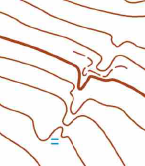Local Geology Day 2
Notes on Geology and Topography of the Balfour Area
Geology
Granite again dominates this area but is different in appearance from the granite that underlies most of the Glen Tanar map. The granite here is full of distinctively large crystals of pink feldspar which give the rock a very coarse grained texture when seen close-up. This texture is described technically as porphyritic and is the result of initial slow cooling of the magma allowing exceptionally large, well-shaped crystals to form. Some upheaval then moved the magma upwards into a cooler environment resulting in more rapid crystallisation of the remaining liquid. This produced a second generation of smaller crystals that formed a matrix for the earlier large crystals. Many older buildings in Aboyne were built using this distinctive porphyritic granite.
As in Glen Tanar, the northern-eastern part of the Balfour map area is underlain by crystalline metamorphic rocks which were once sandstones and calcareous mudstones, the latter belonging to the same Deeside Limestone formation as underlies the village of Aboyne.
Topography
The most interesting contour detail on the Balfour map is provided by a complex area of meltwater channels developed eastwards from the saddle between Black Hill and Creagantoll, the two summits that define the north-east and south-east corners of the map. Brown Hill, the summit at the centre of the map, also has similar patches of gullies and dry channels on its north-eastern slopes as well as on both sides of the col that lies to the south. This col area has the curious name The Arks on the OS Pathfinder map.
Complex networks of parallel and intersecting channels like these provide evidence of short-lived but huge torrents of water that must have poured repeatedly over these eastward facing (and therefore downstream) slopes. Many of these torrents probably flowed beneath successive ice sheets at their interfaces with the land below. Others may have escaped into the open from under retreating edges of ice sheets.
One curious prominent gully runs straight down the NE slopes of Creagantoll. It starts and finishes abruptly and can only be explained as a fragment of a temporary meltwater channel which flowed down through an ice sheet until it hit bedrock, and then eroded a gully which followed the ice/rock interface. After that, the water apparently once more entered a tunnel within the ice. Alternatively, the rest of the gully was erased from the landscape by subsequent erosion or infilled with deposits of rock debris.
 The gully feature described in the text above.
The gully feature described in the text above.
Peter Craig, July 2017